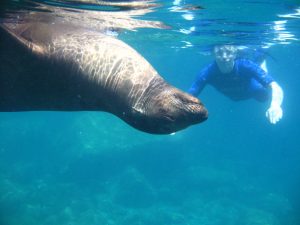by Todos Santos Eco Adventures
The California Sea Lion (Zalophus californianus) is one of the most sociable and fun-loving marine mammals around, and they love to congregate in large colonies of one thousand or more along the Pacific coastline. They are called the lions of the sea because of the loud roars they can produce. The males of some sea lion species also grow thick manes around their necks. From Todos Santos you can visit and interact with sea lions at the famous sea lion colony of Los Islotes in the Sea of Cortez.
Baby sea lions are usually born in late June and are fairly well-developed from day one. Just after birth they can swim a little bit, call for their mothers, and open their eyes. Several days after birth the sea lion mothers leave their youngsters in the rookery and head into the ocean in search of food. When they return they call for their babies with a loud trumpeting noise and the babies reply in a series of bleats. This goes on until mother and pup are reunited. The mother’s final test to determine that she has found her pup is to sniff the pup all over.

Getting to Know the Neighbors: Snorkeler & Sea Lion
Sea lion males are quite impressive in size (and seem especially so when you’re snorkeling nearby), growing up to 8 feet long and 660 pounds. Females are much smaller although they are still the size of a large man, growing up to 6.5 feet long and weighing in at over 200 pounds. As they mature, males grow a crest of bone on the top of their heads, and it is this crest that gives the sea lion its generic name: loph is forehead and za in an emphatic, so Zalophus californianus means “Californian big-head”.
The main difference between a sea lion and a seal in appearance is that sea lions actually have ears, while seals do not. Sea lions are also built to move on both land and water, although they definitely look more graceful in the ocean! The sea lion’s front flippers have a bone structure that is quite similar to that of a human arm and hand. These front flippers propel a sea lion forward while it is swimming, while the rear flippers control steering. The sea lions use both pairs of flippers to walk (waddle) on land.
California sea lions enjoy a wide variety of seafood and feed mainly on squid and fish. Adult females forage for food anywhere between 10 and 3,000 kilometers from the rookery and can dive as deep as 274 meters, with average dives of 31 to 98 meters. Sea lions can stay underwater for up to 15 minutes by sealing their noses shut. The Californian big-head lives to be about 17 in the wild, somewhat longer in captivity.
